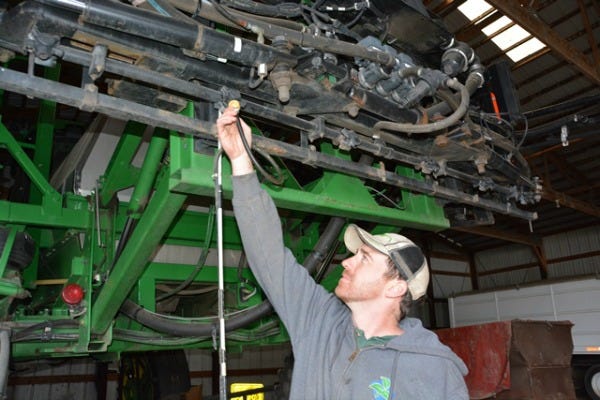May 23, 2016

Craig Olson and his brother, Jeff, and father, Gordon, have a plan to prevent resistant weeds from getting a foothold on their farm.
The Olsons, who farm at Colfax, N.D., in the southern Red River Valley, raise corn, soybeans, sugarbeets and wheat and have a cow-calf herd.
“I’ve seen what can happen [if you let resistant weeds go],” Craig says.
Craig, who is president of the North Dakota Soybean Growers Association, traveled to Tennessee a few years ago and saw soybean and cotton fields that couldn’t be harvested because herbicide resistant Palmer Amaranth had takeover in as little as three years.
Craig says his family doesn’t intend to suffer the same fate.

Craig Olson, Colfax, N.D., and his family have a plan to controlling herbicide resistant weeds on their farm.
“We have a plan,” he says.
The plan starts with crop rotation. Unlike many farmers in the southern Red River Valley, they’ve kept wheat in their rotation. Crops following wheat do better than following other crops. The Olsons are also able to control broadleaf weeds in wheat with lower cost 2-4,D and other products.
They grow Roundup Ready corn and sugarbeets, but alternate between Roundup Ready and Liberty Link soybeans. Liberty Link soybeans typically go on fields that will be planted to sugarbeets the next year so they can use Roundup on the sugarbeets, which are often their highest-value crop.
The Olsons are careful to rotate herbicide modes of action in season and from year-to-year. Jeff has the chore of keeping up with herbicide products and recommending which products to use. Attending educational meetings and working closely with trusted consultants and suppliers is key, he says.
“The mode of action numbering system is a big help,” he says. “It makes it easier to understand what you can do.”

Craig Olson attaches a drop nozzle to their self propelled sprayer boom, which will allow them to spray weeds beneath the corn canopy.
Despite thinner profit margins projected for 2016, the Olsons haven’t cut back on their herbicide budget. In addition to post emergence products, they apply pre-emergence and layby compounds. Their goal is to overlap the residual compounds so the crop canopies and completely shades the ground before the weed control runs out. In corn and sugarbeets, that’s sometimes a challenge. Waterhemp will emerge after throughout the summers after a rain if the ground isn’t completely shaded.
The Olson outfitted their self-propelled sprayer with homemade drop nozzles so they can drive through tall corn and get the herbicide applied below the canopy.
They aim to control all escapes. They use an a all-terrain utility vehicle to spot spray. If spraying isn’t possible, they’ll pull weeds by hand.
“We had to do a lot of it when the kids were young, before we had Roundup,” Gordon says. “It’s no fun, but we will do it.”
The Olsons’ goal is zero weed seed production.

(From left to right) Gordon, Craig and Jeff Olson plan to do whatever is necessary is keep their fields free of herbicide resistant weeds this year.
“It not a matter of if we are going to get herbicide resistant weeds, it’s a matter of when,” Craig says, because flood waters and birds can spread seeds.
“We are treating every weed out there as if it resistant to some herbicide,” Craig says. “We don’t want any to go to seed.”
You May Also Like




